-

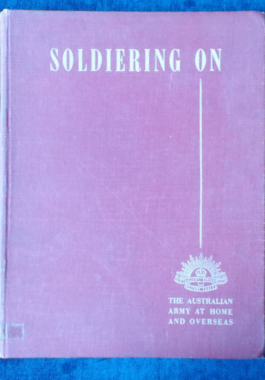 The Australian Army at Home and Overseas, by Some of the Boys and published by the Australian War Memorial, Canberra, 1942. Chapters include: Star Over Bethlehem; Diggers in Britain; Midnight Messiah; Purple's Pup; Arab Justice; Digger v. Doughboy and so much more. Our boys' impressions of Christmas in a cold climate and local customs as well as the American servicemen and women here in Australia. The colour plates, interestingly, are pasted in. Tales, jokes, sketches, cartoons and on-the-spot experiences a-plenty. Illustrated in colour and black and white. A treasure mine of information.
The Australian Army at Home and Overseas, by Some of the Boys and published by the Australian War Memorial, Canberra, 1942. Chapters include: Star Over Bethlehem; Diggers in Britain; Midnight Messiah; Purple's Pup; Arab Justice; Digger v. Doughboy and so much more. Our boys' impressions of Christmas in a cold climate and local customs as well as the American servicemen and women here in Australia. The colour plates, interestingly, are pasted in. Tales, jokes, sketches, cartoons and on-the-spot experiences a-plenty. Illustrated in colour and black and white. A treasure mine of information. -
 June, 1942. Johnnie Houlton has arrived in Britain from New Zealand under the Empire Training Scheme only a few months before. From then on and for the next few years, he was almost constantly in action or seeking action with 485 (NZ) Spitfire Squadron. He volunteered for service in Malta and sharply describes the drama of the convoy that took him there and the five months of siege conditions on the island. Houlton vividly recalls the atmosphere and the incidents of the air war from a pilot's-eye view, together with the development and technique of fighter operations - covering daylight bombing missions, low-level bombing and strafing and the formation of the Second Tactical Air Force in support of land forces. Illustrated with black and white photographs.
June, 1942. Johnnie Houlton has arrived in Britain from New Zealand under the Empire Training Scheme only a few months before. From then on and for the next few years, he was almost constantly in action or seeking action with 485 (NZ) Spitfire Squadron. He volunteered for service in Malta and sharply describes the drama of the convoy that took him there and the five months of siege conditions on the island. Houlton vividly recalls the atmosphere and the incidents of the air war from a pilot's-eye view, together with the development and technique of fighter operations - covering daylight bombing missions, low-level bombing and strafing and the formation of the Second Tactical Air Force in support of land forces. Illustrated with black and white photographs. -
 The story closely follows key events of the Xinhai Revolution, with focus on Huang Xing and Sun Yat-sen. It begins with the Wuchang Uprising of 1911 and follows through historical events such as the Second Guangzhou Uprising on 27 April 1911, the deaths of the 72 martyrs, the election of Sun Yat-sen as the provisional president of the new Provisional Republic of China, the abdication of the last Qing dynasty emperor Puyi on 12 February 1912, and Yuan Shikai becoming the new provisional president in Beijing on 10 March 1912. Also known as Xinhai Revolution and 1911.
The story closely follows key events of the Xinhai Revolution, with focus on Huang Xing and Sun Yat-sen. It begins with the Wuchang Uprising of 1911 and follows through historical events such as the Second Guangzhou Uprising on 27 April 1911, the deaths of the 72 martyrs, the election of Sun Yat-sen as the provisional president of the new Provisional Republic of China, the abdication of the last Qing dynasty emperor Puyi on 12 February 1912, and Yuan Shikai becoming the new provisional president in Beijing on 10 March 1912. Also known as Xinhai Revolution and 1911. -
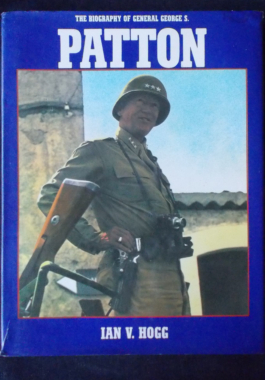
Patton's aggression and theatrical personality made his units the most successful and efficient and he believed that it should be his Army that should lead the Allied attacks. This brought him into constant conflict with Eisenhower and Montgomery, with Patton doing nothing to hide his belief that he would win the war if properly supported. He expected the same aggression from his men and was probably the best American field commander in the European theatre.
-
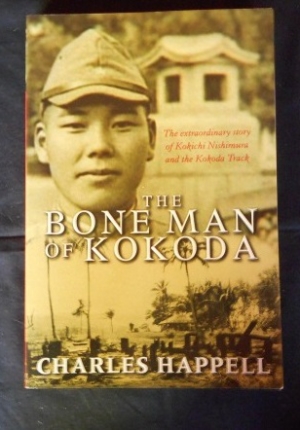
Kokichi Nishimura was a member of the 2nd battalion, 144th regiment of the Japanese Imperial Army. In 1942 he fought every foot of the Kokoda Track as the Japanese attempted to take Port Moresby and was the only man from his platoon to survive the campaign. Finally he retreated, wounded and starving, leaving thousands of his comrades buried in shallow graves along the Track. He promised that he would one day return to them and bring them home to Japan for proper burial. He married, had three children and started an engineering business which prospered. But his driving ambition was to return to New Guinea to keep his promise. In 1979, nearing retirement age, he shocked his family by giving his business to his sons, his house and all his assets to his wife and he returned to New Guinea to begin his search for the remains of Japanese soldiers. For the next 25 years Nishimura lived alone in huts and tents along the Kokoda Track and using a mattock, a shovel, a metal detector and an indomitable will, he found the bones of hundreds of his comrades and also forged a new comradeship and new purpose in helping the poverty-stricken Papuans he worked amongst. An incredible story. Illustrated with black and white photographs.
-
 After Singapore falls to the Japanese early in 1942, 70 000 prisoners - including 15, 000 Australians - are held as POWs at the notorious Changi prison, Singapore. To amuse themselves and fellow inmates, a group of sportsmen - led by the indefatigable and popular `Chicken' Smallhorn - created an Australian Football League, complete with tribunal, selection panel, umpires and coaches. The final game of the one and only season was between `Victoria? and the `Rest of Australia', which attracted 10, 000 spectators and a unique Brownlow Medal was awarded in this unlikely setting under the curious gaze of Japanese prison guards. Meet the main characters behind this spectacle: Peter Chitty, the farm hand from Snowy River country with unfathomable physical and mental fortitude, and one of eight in his immediate family who volunteered to fight and serve in WW2; `Chicken' Smallhorn, the Brownlow-medal winning little man with the huge heart; and `Weary' Dunlop, the courageous doctor, who cares for the POWs as they endure malnutrition, disease and often inhuman treatment. Illustrated with black and white photographs.
After Singapore falls to the Japanese early in 1942, 70 000 prisoners - including 15, 000 Australians - are held as POWs at the notorious Changi prison, Singapore. To amuse themselves and fellow inmates, a group of sportsmen - led by the indefatigable and popular `Chicken' Smallhorn - created an Australian Football League, complete with tribunal, selection panel, umpires and coaches. The final game of the one and only season was between `Victoria? and the `Rest of Australia', which attracted 10, 000 spectators and a unique Brownlow Medal was awarded in this unlikely setting under the curious gaze of Japanese prison guards. Meet the main characters behind this spectacle: Peter Chitty, the farm hand from Snowy River country with unfathomable physical and mental fortitude, and one of eight in his immediate family who volunteered to fight and serve in WW2; `Chicken' Smallhorn, the Brownlow-medal winning little man with the huge heart; and `Weary' Dunlop, the courageous doctor, who cares for the POWs as they endure malnutrition, disease and often inhuman treatment. Illustrated with black and white photographs. -

It was at Dunkirk that Toosey's charisma and fortitude were first noted and in 1941 he was given command of an artillery regiment. Sent to fight in the Far East he and his men were embroiled in the battle for Singapore and were taken prisoner after the island's fall in 1942. The Japanese, scornful of the Allied forces for surrendering, determined to make use of the new workforce now at their disposal. Toosey was sent to Thailand to command the 'bridge camp' at Tamarkan where he was ordered to supervise the construction of two railway bridges over the river Khwae Mae Khlong. Starvation rations and harsh working conditions mean that dysentery and cholera were rife and a quarter of the 60,000 prisoners working on the Burma Railway wold perish. Toosey insisted on high standards of hygiene and discipline, giving back the men their self-respect and making himself a buffer for the cruel excesses if the guards. The author is Toosey's grand-daughter. Illustrated with black and white photographs and sketches.
-
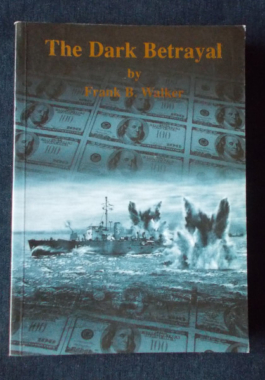
Ken Bartlett, an Australian sailor in a corvette in the Atlantic, took on a cloak-and-dagger mission into Nazi Germany. It was the start of a long and dangerous trail that led him to suspect that Allied firms traded with Germany and Japan during World War II. After arduous service in corvettes in both the Atlantic and the Pacific, he returned to his job as a journalist and followed the scent of the treason trade. This proved even more hazardous, with the FBI, CIA and thugs hired by the double-dealers out to get him. He achieved a victory - yet it was bitter.
-
 As we crowded the decks off Gallipoli and watched the first shells crash into Turkish soil... Trooper Ion L. Idriess of the 5th Australian Light Horse began keeping a diary. Over the next three years as the regiment moved onto Palestine, stormed Beersheba and pushed into the Sinai, his diary grew and became one of the most vivid pieces of war narrative ever written. Unconcerned with grand strategy or moralisations, Idriess records the realities of his war - maggot-ridden trenches crowded with the corpses of his mates, the good friendships, the bad tucker, the heat, the dust, the boredom of desert patrols - and always the fighting and his reactions to it, which reveal far better than mere description, since he was there. The rifle fire grew to a roar that drowned the voice of the man next to me. I felt as a stone age man might feel if volcanoes all around him suddenly spat life and roared...Believed to be Idriess' earliest work.
As we crowded the decks off Gallipoli and watched the first shells crash into Turkish soil... Trooper Ion L. Idriess of the 5th Australian Light Horse began keeping a diary. Over the next three years as the regiment moved onto Palestine, stormed Beersheba and pushed into the Sinai, his diary grew and became one of the most vivid pieces of war narrative ever written. Unconcerned with grand strategy or moralisations, Idriess records the realities of his war - maggot-ridden trenches crowded with the corpses of his mates, the good friendships, the bad tucker, the heat, the dust, the boredom of desert patrols - and always the fighting and his reactions to it, which reveal far better than mere description, since he was there. The rifle fire grew to a roar that drowned the voice of the man next to me. I felt as a stone age man might feel if volcanoes all around him suddenly spat life and roared...Believed to be Idriess' earliest work. -
 Using secret American, British and German sources previously unavailable, this story appears almost incredible. Few people know that behind all of the great decisions- and many of the small ones - of the past two world wars, lay information gathered from secret intelligence, either from agents or intercepted coded messages. At the time of writing the whole structure was still classified, yet Farago was able to obtain German records that had been lost for a generation, revealing a vast espionage network strung across Britain and the United States. He also shows how the Germans mopped up the British espionage network in 1939, and how it was painfully and carefully rebuilt by a new generation of British intelligence officers who cracked the German codes and fed false information to the Abwehr throughout the war, eventually contributing to the defeat of the Axis powers.
Using secret American, British and German sources previously unavailable, this story appears almost incredible. Few people know that behind all of the great decisions- and many of the small ones - of the past two world wars, lay information gathered from secret intelligence, either from agents or intercepted coded messages. At the time of writing the whole structure was still classified, yet Farago was able to obtain German records that had been lost for a generation, revealing a vast espionage network strung across Britain and the United States. He also shows how the Germans mopped up the British espionage network in 1939, and how it was painfully and carefully rebuilt by a new generation of British intelligence officers who cracked the German codes and fed false information to the Abwehr throughout the war, eventually contributing to the defeat of the Axis powers. -
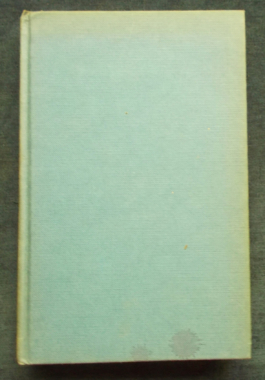
 They were American and British air force officers in a German prison camp. With only their bare hands and the crudest of homemade tools, they sank shafts, forged passports, faked weapons, and tailored German uniforms and civilian clothes. They developed a fantastic security system to protect themselves from German surveillance. It was a split-second operation as delicate and as deadly as a time bomb. It demanded the concentrated devotion and vigilance of more than six hundred men - every one of them, every minute, every hour, every day and night for more than a year. With black and white photographs.
They were American and British air force officers in a German prison camp. With only their bare hands and the crudest of homemade tools, they sank shafts, forged passports, faked weapons, and tailored German uniforms and civilian clothes. They developed a fantastic security system to protect themselves from German surveillance. It was a split-second operation as delicate and as deadly as a time bomb. It demanded the concentrated devotion and vigilance of more than six hundred men - every one of them, every minute, every hour, every day and night for more than a year. With black and white photographs. -

The Holy Fox: Andrew Roberts
$95.00The life of Lord Halifax, remembered as the architect of the policy of achievement of Nazi Germany. His meeting with Hitler in 1937 was a milestone in appeasement yet just days before the 1938 Munich conference, Halifax repudiated the policy and demanded the destruction of Nazism. By May 1940, it was he rather than Churchill who was the choice for Britain's war leader. His public life also included Viceroy of India from 1926 - 31 and a deal with Gandhi that ended the Civil Disobedience campaign before it could force the British to quit. -
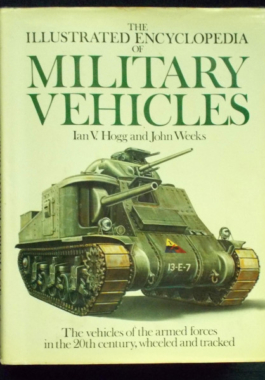 The use and development of motorised vehicles by the armed forces of the twentieth century is a complex and fascinating subject. While many books are devoted specifically to tanks, trucks and so on, this lavishly illustrated and comprehensive encyclopedia sets out to provide a complete and authoritative guide to motorised military vehicles of all categories - from the first quadricycles and armoured cars of the late nineteenth and early twentieth century to the 1980s. https://cosmiccauldronbooks.com.au/p/biography-general-george-s-patton-ian-v-hogg/
The use and development of motorised vehicles by the armed forces of the twentieth century is a complex and fascinating subject. While many books are devoted specifically to tanks, trucks and so on, this lavishly illustrated and comprehensive encyclopedia sets out to provide a complete and authoritative guide to motorised military vehicles of all categories - from the first quadricycles and armoured cars of the late nineteenth and early twentieth century to the 1980s. https://cosmiccauldronbooks.com.au/p/biography-general-george-s-patton-ian-v-hogg/ -
 Most dramas end in anti-climax, but not in Nazi Germany. Everything about its demise was tragic crescendo. This is a dramatic countdown of the final months of World War II in Europe, bringing to life the waning power and the ultimate submission of the Third Reich. To reconstruct the tumultuous hundred days between Yalta and the fall of Berlin, John Toland traveled more than 100,000 miles in twenty-one countries and interviewed more than six hundred people - from Hitler’s personal chauffeur to Generals von Manteuffel, Wenck, and Heinrici; from underground leaders to diplomats; from top Allied field commanders to brave young GIs. When it was first published, The Last 100 Days made history, revealing after-action reports, staff journals, and top-secret messages and personal documents previously unavailable to historians. Illustrated with black and white archival photographs.
Most dramas end in anti-climax, but not in Nazi Germany. Everything about its demise was tragic crescendo. This is a dramatic countdown of the final months of World War II in Europe, bringing to life the waning power and the ultimate submission of the Third Reich. To reconstruct the tumultuous hundred days between Yalta and the fall of Berlin, John Toland traveled more than 100,000 miles in twenty-one countries and interviewed more than six hundred people - from Hitler’s personal chauffeur to Generals von Manteuffel, Wenck, and Heinrici; from underground leaders to diplomats; from top Allied field commanders to brave young GIs. When it was first published, The Last 100 Days made history, revealing after-action reports, staff journals, and top-secret messages and personal documents previously unavailable to historians. Illustrated with black and white archival photographs. -

From the author of The Longest Day. On Monday, April 16, 1945, an artillery barrage announced the opening Russian attack against Berlin. Russian troops were less than thirty-eight miles from Berlins centre. In fourteen days Hitler would be dead. In twenty-one days, the war would be over. Forty-five miles to the west, advance units of the U.S. Ninth army were angrily and reluctantly turning back. Berlin was no longer a military objective. This book is the story of three weeks in which the city of Berlin - gutted, smouldering, terrorised, yet miraculously still alive - was the focal point of millions of lives: the last obstacle of the triumphant Allies, the last defence for the Germans and the last refuge for Hitler. Illustrated with black and white photos.
-
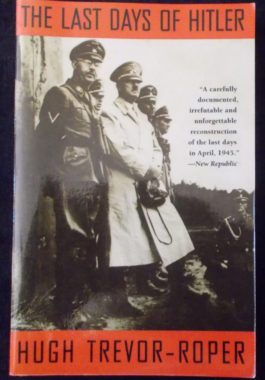 In September 1945, the fate of Hitler was a complete mystery. He had simply disappeared, missing for four months. The author, a British counter-intelligence officer, was given the task of solving this mystery. His brilliant piece of detective work not only proved that Hitler had killed himself in Berlin, but also produced one of the most fascinating history books ever written, telling the extraordinary story of those last days in the Berlin Bunker. Chapters include: Hitler and His Court; Hitler In Defeat; The Court in Defeat; Crisis and Decision; Siege of the Bunker. Et Tu, Brute. The Death of Hitler. Epilogue.
In September 1945, the fate of Hitler was a complete mystery. He had simply disappeared, missing for four months. The author, a British counter-intelligence officer, was given the task of solving this mystery. His brilliant piece of detective work not only proved that Hitler had killed himself in Berlin, but also produced one of the most fascinating history books ever written, telling the extraordinary story of those last days in the Berlin Bunker. Chapters include: Hitler and His Court; Hitler In Defeat; The Court in Defeat; Crisis and Decision; Siege of the Bunker. Et Tu, Brute. The Death of Hitler. Epilogue. -

 Australian Richard Hillary joined RAF Fighter Command’s 603 Squadron in July 1940, then based in Scotland and flying the new Supermarine Spitfire. On 27 August 1940 the squadron moved south to London, the epicentre of the Battle of Britain, and within a week Hillary had shot down five Messerschmitt 109s, becoming an ‘ace’. But on his last sortie he was shot out of the sky over Dungeness, the cockpit of his Spitfire became engulfed in flames and Hillary was grievously burned as he desperately tried to bale out. Hillary was soon to become the most famous patient of the RAF’s pioneering plastic surgeon, Archibald McIndoe, and member of his ‘Guinea Pig Club’. He would endure months of painful surgery in an attempt to repair the damage to his hands and face, and allow him to return to active duty. Originally published in 1942, just months before he died in a second crash, The Last Enemy recounts the struggles and successes of a young man in the Royal Air Force.
Australian Richard Hillary joined RAF Fighter Command’s 603 Squadron in July 1940, then based in Scotland and flying the new Supermarine Spitfire. On 27 August 1940 the squadron moved south to London, the epicentre of the Battle of Britain, and within a week Hillary had shot down five Messerschmitt 109s, becoming an ‘ace’. But on his last sortie he was shot out of the sky over Dungeness, the cockpit of his Spitfire became engulfed in flames and Hillary was grievously burned as he desperately tried to bale out. Hillary was soon to become the most famous patient of the RAF’s pioneering plastic surgeon, Archibald McIndoe, and member of his ‘Guinea Pig Club’. He would endure months of painful surgery in an attempt to repair the damage to his hands and face, and allow him to return to active duty. Originally published in 1942, just months before he died in a second crash, The Last Enemy recounts the struggles and successes of a young man in the Royal Air Force. -
 "Learn all you can about the German Army and one day you will be a valuable man to your country." These words were spoken to young Alexander Scotalnd by Major Wade, a British liaison officer in German West Africa in 1904. He never forgot those words. This book covers how much he learnt and how valuable were his services to his country. This young man served in the German Army - at the suggestion of the Germans - for the duration of the Hottentot Rebellion, thereby gaining an intimate knowledge of the organisation and strengths of the German military machine. He grew to know, by close contact, the habits, language and mental outlook of the German soldier. This knowledge was the basis of his achievements in espionage, interrogation and undercover work in two world wars. His reputation led to a strange meeting with Adolf Hitler in 1937, at the home of a mutual friend. His career reached its zenith in 1947 when - as Chief Officer of the War Crimes Investigation Unit, he played a decisive role in bringing Nazi war criminals to justice. Illustrated with black and white photographs.
"Learn all you can about the German Army and one day you will be a valuable man to your country." These words were spoken to young Alexander Scotalnd by Major Wade, a British liaison officer in German West Africa in 1904. He never forgot those words. This book covers how much he learnt and how valuable were his services to his country. This young man served in the German Army - at the suggestion of the Germans - for the duration of the Hottentot Rebellion, thereby gaining an intimate knowledge of the organisation and strengths of the German military machine. He grew to know, by close contact, the habits, language and mental outlook of the German soldier. This knowledge was the basis of his achievements in espionage, interrogation and undercover work in two world wars. His reputation led to a strange meeting with Adolf Hitler in 1937, at the home of a mutual friend. His career reached its zenith in 1947 when - as Chief Officer of the War Crimes Investigation Unit, he played a decisive role in bringing Nazi war criminals to justice. Illustrated with black and white photographs. -
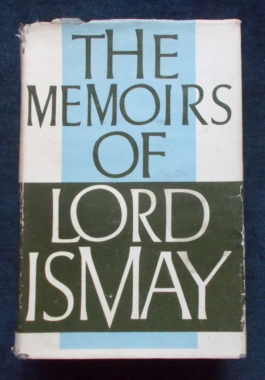 The appointment of Major-General H.L. Ismay to the Chiefs of Staff Committee was made on May 1st, 1940, when Churchill was First Lord of the Admiralty. On May 10th he succeeded Chamberlain as Prime Minister and Ismay's position at once became of the first importance. His functions were ill defined. He liked to call himself Churchill's "agent"; but he was very much more than that term usually implies. Out of his close association with the Prime Minister there grew a deep understanding and friendship. Accompanying him everywhere from blitzed areas in London to major conferences all over the world, or sharing with him his moments of relaxation after the heat of the day, Ismay had unique opportunities to observe the Colossus who was his master and his memoir paints a full portrait of Churchill. In 1925 Ismay was appointed Assistant Secretary to the Committee of Imperial defence. By the outbreak of the Second World War he was very experienced in committee work. The waging of total war in a democracy is a complex business: committees and conferences have to do their work, temperaments have to be reconciled and methods of implementing decisions arrived at. It is this aspect of the war covered by Lord Ismay. He was important as a peacemaker and mediator; there was no lack of potential friction between the Chiefs of Staff and their political superiors in World War II and the fact that this friction remained largely potential was largely due to Ismay. After his years in India, Somaliland and Whitehall and his work in World War II, he returned post-war to India as the personally invited advisor to the Viceroy, Lord Mountbatten, to contribute to the settlement of Partition, and after its successful conclusion Lord Ismay crowned his career of public service as the head of the North Atlantic Treaty Organization (NATO) where he strove to prevent a future war with the same energy as he had helped to win the past one.
The appointment of Major-General H.L. Ismay to the Chiefs of Staff Committee was made on May 1st, 1940, when Churchill was First Lord of the Admiralty. On May 10th he succeeded Chamberlain as Prime Minister and Ismay's position at once became of the first importance. His functions were ill defined. He liked to call himself Churchill's "agent"; but he was very much more than that term usually implies. Out of his close association with the Prime Minister there grew a deep understanding and friendship. Accompanying him everywhere from blitzed areas in London to major conferences all over the world, or sharing with him his moments of relaxation after the heat of the day, Ismay had unique opportunities to observe the Colossus who was his master and his memoir paints a full portrait of Churchill. In 1925 Ismay was appointed Assistant Secretary to the Committee of Imperial defence. By the outbreak of the Second World War he was very experienced in committee work. The waging of total war in a democracy is a complex business: committees and conferences have to do their work, temperaments have to be reconciled and methods of implementing decisions arrived at. It is this aspect of the war covered by Lord Ismay. He was important as a peacemaker and mediator; there was no lack of potential friction between the Chiefs of Staff and their political superiors in World War II and the fact that this friction remained largely potential was largely due to Ismay. After his years in India, Somaliland and Whitehall and his work in World War II, he returned post-war to India as the personally invited advisor to the Viceroy, Lord Mountbatten, to contribute to the settlement of Partition, and after its successful conclusion Lord Ismay crowned his career of public service as the head of the North Atlantic Treaty Organization (NATO) where he strove to prevent a future war with the same energy as he had helped to win the past one. -

The author has written the full length story of the Malayan campaign of World War II from the 'sharp end' of the fighting and as a prisoner-of-war, one of thousands who suffered for three years. He takes the reader through bewildering, disordered days and nights of fighting to humiliation at the hands of the Japanese, versed in all the arts of abasing and breaking prisoners by starvation and neglect. The illustrations by fellow prisoner Ronald Searle (St. Trinians, Down With Skool,Whizz For Atomms, How To Be Top, etc.) are poignant, forceful and make reality even more real. This really is war and imprisonment as it happened.
-
 A volume of military activity, weaponry and technology from 1987. Arenas of activity covered: The Middle East - Tripoli; Lebanon; the Gulf War; South Yemen and the Arab-Israeli conflict. Europe, North America and the Soviet Union: Terrorism and Power Politics; The Superpower Relationship; NATO and the Warsaw Pact; International Terror; Northern Ireland. Asia - Islam's Guerrillas; The Tamil Tigers; The Philippines; Vietnam and Cambodia' Sikh Separatists. Africa - South Africa; Mozambique; Angola; Chad; The Sudan; Ethiopia; The Boy Soldiers of Uganda. Latin America: Guerrillas and Contras; El Salvador; Nicaragua; Peru; Chile. Military Technology: The War Machine; Aerial Warfare; Space and Missiles; Land Warfare; Naval Warfare. A wealth of information for the war history buff with plenty of colour photographs.
A volume of military activity, weaponry and technology from 1987. Arenas of activity covered: The Middle East - Tripoli; Lebanon; the Gulf War; South Yemen and the Arab-Israeli conflict. Europe, North America and the Soviet Union: Terrorism and Power Politics; The Superpower Relationship; NATO and the Warsaw Pact; International Terror; Northern Ireland. Asia - Islam's Guerrillas; The Tamil Tigers; The Philippines; Vietnam and Cambodia' Sikh Separatists. Africa - South Africa; Mozambique; Angola; Chad; The Sudan; Ethiopia; The Boy Soldiers of Uganda. Latin America: Guerrillas and Contras; El Salvador; Nicaragua; Peru; Chile. Military Technology: The War Machine; Aerial Warfare; Space and Missiles; Land Warfare; Naval Warfare. A wealth of information for the war history buff with plenty of colour photographs. -
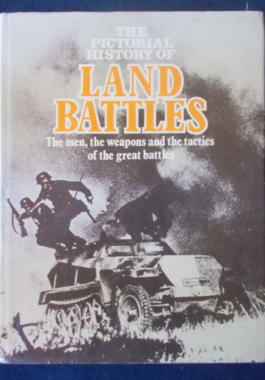 A book full of information, pictures and maps of land battles throughout history that proves it was not always about who had the biggest army. In this volume - Metaurus - after the toughest forced march in history, Nero slays Hasdrubal; Agincourt - massed archers and infantry slaughter the French cavalry; Bunker Hill - a thousand farmers ignite the flame of American independence; Austerlitz - Napoleon crushes an army bigger than his own; Balaclava - a battle of idiocy and sheer courage; Second Bull Run - a high spot for the South in the American Civil War; The Somme - slaughter on a scale never seen before or since; Cambrai - tanks explode into action for the first time; Gazala - Rommels' fast moving tactical brilliance; Stalingrad - Hitler's obstinacy leads the Wehrmacht to disaster; Cassino and Anzio - Allied forces combine to force a breakthrough; The Battle Of The Bulge - fast moving Panzers against Eisenhower, Montgomery and Patton; Operation Commando - a true 'United Nations; against the Chinese in Korea. Illustrated with archival photographs, artists' representations and maps.
A book full of information, pictures and maps of land battles throughout history that proves it was not always about who had the biggest army. In this volume - Metaurus - after the toughest forced march in history, Nero slays Hasdrubal; Agincourt - massed archers and infantry slaughter the French cavalry; Bunker Hill - a thousand farmers ignite the flame of American independence; Austerlitz - Napoleon crushes an army bigger than his own; Balaclava - a battle of idiocy and sheer courage; Second Bull Run - a high spot for the South in the American Civil War; The Somme - slaughter on a scale never seen before or since; Cambrai - tanks explode into action for the first time; Gazala - Rommels' fast moving tactical brilliance; Stalingrad - Hitler's obstinacy leads the Wehrmacht to disaster; Cassino and Anzio - Allied forces combine to force a breakthrough; The Battle Of The Bulge - fast moving Panzers against Eisenhower, Montgomery and Patton; Operation Commando - a true 'United Nations; against the Chinese in Korea. Illustrated with archival photographs, artists' representations and maps. -
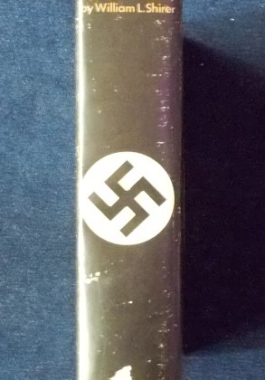
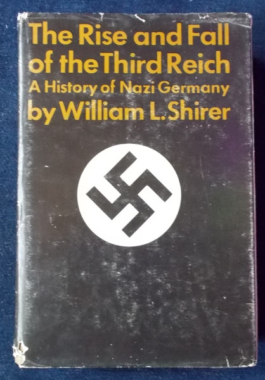
Here for the first time is the complete history of Hitler's empire. No other empire ever bequeathed to historians such mountains of evidence about its rise and fall as the Third Reich. The Allied demand for unconditional surrender produced - before the Nazis could destroy their files - an almost hour-to-hour record of the nightmare realm created by Hitler. This record includes the testimony of Nazi leaders, concentration camp inmates, the diaries of officials, transcripts of secret conferences, army orders, private letters - all the vast paper work behind a conspiracy to conquer the world. This is also the story of Hitler the man - his love affairs, his imprisonment, his suicide. There is also details of the plot to kidnap the Duke and Duchess of Windsor and hundreds of other inside stories. Most of all, it is the story of how Hitler destroyed his beloved Germany. The author, who watched and reported on the Nazis since 1925 had been reporting on-the-spot from Germany and Europe for almost forty years and spent over five years sifting the mountains of paper that eventually became this definitive history.
-
 World War II gave rise to an astonishing number of unorthodox 'special forces' yet this is the first book to assess their contribution to the final victory or how they related to one another and to the more conventional fighting forces. In 1939 'Special Forces' did not exist; it was Churchill who ordered them to 'set Europe ablaze'. Operating under the cloak of secrecy during wartime and quickly disbanding after it they have not often received credit for their achievements. From early 'butcher and bolt' raids by parachutists and commandos to SOE activities in the Balkans and France; 'Merrill's Marauders' and Windgate's Chindits in Burma, Special Forces were active in all great theatres of war. They played a vital role in intelligence-gathering, Anglo-American co-operation, sabotage, the fostering of local resistance movements and guerilla fighting. They denied 'heavy water' to Germany, making it impossible for that country to manufacture an atomic bomb and crucially affected the balance of air power in the Western Desert in 1942. Here are survivors' stories - courageous men and women, many of whom have become legendary. With black and white photographs.
World War II gave rise to an astonishing number of unorthodox 'special forces' yet this is the first book to assess their contribution to the final victory or how they related to one another and to the more conventional fighting forces. In 1939 'Special Forces' did not exist; it was Churchill who ordered them to 'set Europe ablaze'. Operating under the cloak of secrecy during wartime and quickly disbanding after it they have not often received credit for their achievements. From early 'butcher and bolt' raids by parachutists and commandos to SOE activities in the Balkans and France; 'Merrill's Marauders' and Windgate's Chindits in Burma, Special Forces were active in all great theatres of war. They played a vital role in intelligence-gathering, Anglo-American co-operation, sabotage, the fostering of local resistance movements and guerilla fighting. They denied 'heavy water' to Germany, making it impossible for that country to manufacture an atomic bomb and crucially affected the balance of air power in the Western Desert in 1942. Here are survivors' stories - courageous men and women, many of whom have become legendary. With black and white photographs.








